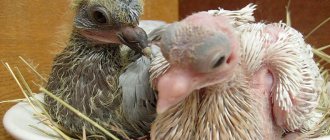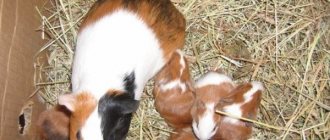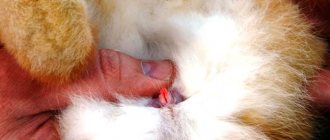How are rabbits bred?
If a farmer decides to breed rabbits, engage in mating and littering, he should know the methods of breeding these furry animals. There are only three ways:
- Breeding at home in a natural environment. For effective fertilization, it is necessary to place the male and female in the same cage for two days and observe them so that the natural process occurs. Not everything can always work out the first time, even if you wait a longer period of time. Therefore, some farmers immediately plant several females and one male.
- Breeding rabbits with human participation. This method is practically no different from that described above, only in this case you should hold the female so that the male can cover her.
- Breeding on large farms. This method is used when many rabbits are bred. Therefore, for maximum confidence in the result, insemination of females is carried out using the artificial method. Of course, this method cannot be called simple, since in order to turn your plans into reality, you need to know several nuances. First of all, it is necessary to collect the sperm of rabbits, and only the venerable ones, and then place the sperm inside the rabbit using a syringe.
This is important to know
If you are too late to create favorable conditions for childbirth, the rabbit may give birth directly on the net. She will pinch the fluff and run around the cage. Newborn rabbits can be trampled or eaten. As a result, if a female rabbit gives birth for the first time, she will develop the habit of eating her offspring and will have to be culled
Therefore, it is very important to create favorable conditions for childbirth. You need to take care of this in advance, during pregnancy.
Therefore, it is important to know when your rabbits will give birth and how long they stay pregnant. It is impossible to determine the pregnancy of a rabbit by eye, but in the last week of this period you can feel the baby rabbits in the stomach, and also, by placing your hand on the stomach, feel how they move.
Determination of gender
Before you start breeding rabbits, you should determine their gender. This is not as simple as it might seem at first glance. Moreover, such an activity will seem difficult for a person who is encountering this for the first time.
To determine the sex, you need to place the rabbit on its back, lower its tail, and press with your fingers on both sides near the rabbit's genitals. In a female individual, the genitals look like a loop or hood with a slit (genital slit). In males, the genital organ is formed in the form of a tube with a round hole in the middle.
Lay the rabbit on its back
Press on both sides to bring out the genitals
The female genitalia looks like a loop
Female rabbit genital slit
The male rabbit's external genitalia has the shape of a tube.
Rabbit reproductive organ
Costs and profits
Breeding and keeping rabbits has a great advantage, which is their fertility.
One female, with good care, can handle 10 litters per year. And this is 50-60 cubs from one rabbit. From 60 female rabbits it is possible to get 3600 female rabbits. This is 7200 g of meat. If you sell meat at 300 rubles per kg, you can earn 2,160,000 rubles a year. 50% of the profit goes to necessary expenses:
- Feed;
- fare;
- electricity;
- salary for hired workers;
- purchase and routine repair of cages;
- veterinary expenses (plus vaccinations).
If you work without hired workers and carry out vaccinations yourself, costs are reduced.
Choosing the right rabbit
Choosing a female rabbit for mating is not so difficult. First, assess the age of the animal: the female should not be younger than 6 months, since at a younger age she will not be able to bear offspring normally. Of course, the best option would be young individuals who have already given birth to rabbits and then conscientiously fed them. In this case, already 45 days after the previous litter, the female can be bred again.
It happens that a mother rabbit eats her babies. If this happened, there is no need for this female to happen again.
An equally important criterion for choosing a young rabbit to mate with is her weight. The female should be moderately well-fed, but not suffer from obesity. If the animal is thin, you should start fattening it. The female rabbit must be in the hunting stage, because without this the mating will not work. If a specific day of the month has been selected for mating, the female should be separated from her relatives for a while.
Coating
If the farm does not practice artificial insemination, the reproduction process occurs in two ways.
The first mating method assumes its duration is a week, 5 or 7 days. Animals are given the right to choose the appropriate mating option themselves. Initially, the animals are observed. It happens that one partner does not like the other, and a fight may arise. To prevent the animals from mutilating each other, one will have to be separated.
According to the second method, the female is placed with the rabbit for a short period of time from 2 to 3 hours. But the livestock breeder will have to constantly monitor his charges, and if necessary, he will have to intervene. When the coating has occurred, the rabbit breeder usually sees it as a thirty-second process. When the covering is completed, the male lies on his side, his characteristic squeaking sound is heard, which means that the owner can seat the partners.
Advice: When there is a lot of flirting between partners, and the act of reproduction is postponed, the rabbit breeder needs to hold the female, allowing the rabbit to quickly fulfill its duty.
How do you know when it's time to mate rabbits?
To reproduce offspring, you must wait until the rabbits reach full puberty. The age at maturity is slightly different for each breed. Next, you need to wait a couple more months for your body to get stronger. It turns out that on average, the first mating takes place at 5-6 months. This is the most optimal age.
If the rabbit begins to actively mark the territory, this indicates that the male is ready for mating. Requirements for males:
- activity;
- healthy appearance and sufficient weight.
If a rabbit sheds, it is better to postpone mating for this period, since in a state of molting the animal’s immunity is weakened, which can negatively affect the quality of the litter.
As for the female, she must have a desire to mate. This is easy to understand: the female’s behavior becomes restless, she often moves around the cage, and can pluck her down to improve the future nest. In addition, the female's loop swells and acquires a bright pink color. And if you stroke the rabbit’s back, she will lie down and begin to stretch out. Sexual desire in females occurs regularly (every 7-9 days).
You can mate rabbits without the female hunting, but the effectiveness of such mating will be low, since the rabbit’s body needs about 5 days to mature the eggs. Therefore, it is still recommended to regularly check the female’s heat before mating. And during the mating process itself, you need to hold the female rabbit so that her back is raised and her tail does not interfere with the penetration of the male’s genital organ into her.
The female is considered covered when the male, after a couple of minutes of rapid movements, abruptly stops in a certain position or jumps off the female, making snoring sounds. Mating can be repeated after 5-7 days. The convenience is that you don’t have to wait for the right day to mate.
While in humans pregnancy can only occur on certain days, in rabbits ovulation occurs spontaneously immediately after intercourse. Nature intends for rabbits to reproduce regularly. By the way, female rabbits do not have estrus (menstruation).
If the female refuses to accept the male upon repeated mating, then most likely she is already pregnant. You need to carefully feel her lower abdomen. In a pregnant female, on days 13-15 after successful mating, two parallel threads of soft balls the size of a cherry will be palpable. The rabbit is placed separately and is no longer probed so as not to cause a miscarriage.
Preparatory stage
Age
It is not recommended to bring animals over 6 years old. Males at this age are already significantly overweight and are not able to fertilize a female rabbit. Females are likely to give birth to weak offspring, and their milk will not be enough to fully feed the cubs. The same problems arise in animals after 5-6 births - they are also culled.
Male choice
It is best to select several breeding individuals in advance (their number depends on the total livestock, at least two), they will continue the family line, passing on strong qualities to the offspring. The ideal candidates for rabbits are males that meet the following parameters:
- the animal was born in the first or second litter;
- being small, the little rabbit stood out among its fellows for its size and activity;
- the male has already experienced 2 molts;
- by the time of mating, the external characteristics of the animal indicate its health (normal weight, strong muscles, high-quality fur, lively temperament);
- The animal has 2 testes, and the genitals appear to be well developed.
Female choice
Proper selection of a pair contributes to the breeding of healthy offspring.
Since the health of the offspring largely depends on the female rabbit, she should also be carefully examined before mating, giving preference to the following individuals:
- the female has an optimal weight for conception (2.5 kg for small breeds, 5 kg for large breeds);
- if the female rabbit sheds, mating is postponed, since at this time her body is weakened;
- the external characteristics of the animal correspond to the breed standards;
- preference is given to animals with an easy-going disposition; aggressive animals will create many problems for the owner after birth;
- if the female has less than 8 nipples, or they are poorly developed, difficulties will arise with feeding the rabbits - such individuals are discarded;
- the rabbit is healthy.
Culling
Each pair of rabbits undergoes a periodic culling test.
Males are paid attention to after mating, and if they fertilize only two out of three female rabbits (or less), such animals are not suitable for breeding stock. Females are screened out according to several criteria:
- problems with conception;
- the number of cubs was repeatedly less than 4;
- The rabbit ate her babies.
Nutrition
After selecting a pair, rabbits need to be provided with proper nutrition. Since excess weight does not contribute to fertilization, animals should be fed in moderation. But cutting back on your diet sometimes leads to excessive weight loss. What to do if the selected individual shows the first signs of exhaustion? 2 weeks before mating, give the animals more oats, potatoes, and meadow grass hay. During the mating period, rabbits will need a significant amount of vitamins and microelements to replenish energy costs. This is especially true in winter.
During the mating period, animals need to increase the amount of vitamins and microelements in their food.
Readiness of the rabbits
Mating is carried out only when the female rabbit is in heat, that is, her body is maximally tuned to successful fertilization. The duration of this period is usually 2 - 5 days with a cycle of 5 - 7 days in summer and 8 - 10 in winter. At any other time, the female will not be able to conceive or simply will not let the male in. Therefore, let’s consider what external signs that the rabbit is ready for mating will be observed by the owner:
- the animal is nervous and does not find a place for itself;
- takes hay in its teeth and carries it from one corner of the cage to another;
- tries to turn over the feeder;
- periodically lies on his stomach, tucking his paws in;
- urinates frequently;
- if you touch the back of the case, it immediately rises;
- The female's genitals are red and slightly swollen.
At what age can rabbits be bred?
To determine the age for mating as correctly as possible, one should take into account the fact that rabbits do not live long, about 9-10 years, and already from the 5th year of life the percentage of successful matings drops, therefore it is recommended not to mate. In addition, in old age there is a sharp decrease in the volume of milk in female rabbits after the birth of offspring, so the female cannot feed them on her own.
In rabbits, the process of aging and the extinction of maternal instincts is an individual feature. It often happens that, by all academic parameters, a male or female is subject to culling, but at the same time they still produce numerous and healthy offspring. But as statistics show, regardless of the age at which the first mating occurred, the animal can give birth to strong young rabbits during the first 2-3 years of its life.
Feeding
Rabbits need to be fed in a balanced manner so that they can produce good offspring, meat and wool. A rabbit can eat continuously throughout the day.
First, it is better to feed the animal with ready-made mixed feed, which contains all the necessary microelements balanced.
In summer, the basis of the diet is greens - branches, foliage, grass, etc. Branches of fruit trees, acacia, birch, and willow are especially useful for rabbits.
You can also give tops of garden crops. The animal loves bitter and aromatic herbs: wormwood, chicory, dill. In addition, they protect against worms and improve appetite. Dried garlic stalks are recommended for young animals to prevent stomatitis and gastrointestinal diseases.
Nettle, which is collected before flowering and dried in the shade, is rich in vitamins. It is recommended to be given as the first spring greens.
Since it can sting an animal, it must first be crushed and chopped. Willow branches are also useful for young animals, as they protect against diarrhea. They feed the rabbits before switching to greens.
In winter and early spring, rabbits are given fortified supplements , which are contained mainly in root vegetables. This is especially important for nursing rabbits. Rowan berries are rich in vitamins.
Read more about feeding rabbits in winter here.
In late autumn, rabbits can eat vegetable tops and dry flower stems. At the beginning of November, when the green leaves are gone, the animals are switched to mineral feed in granules. During this period, rabbits are fattened, given a lot of feed and feed grain.
In winter, tree branches can be added to the hay for feed. They replace hay in the diet by half. Grain can be replaced with potato peelings or grain waste.
It is also worth considering that rabbits have difficulty adapting to new food. Therefore, they need to be accustomed to it gradually, increasing the dose over time.
To determine the annual feed requirement of rabbits, you need to take into account a number of factors:
- duration of feeding in summer and winter;
- number of litters per year;
- age of sale of young animals (slaughter, sale or replenishment of the herd);
- live weight of rabbits;
- diet in different seasons.
Average amount of feed per year in kilograms for adults:
- coarse: for females 35-40, for males 23-35;
- juicy: for females 50-60, for males 40-50;
- green: for females 200-250, for males 150-160;
- concentrated feed: for females 35-35, for males 22-25.
Pregnant and nursing
At this time, proper varied nutrition is especially important, because underfeeding causes disruptions in the normal development of embryos and reduces milk production in a lactating female.
In summer, the female is given a large amount of dried grass, in winter - high-quality hay. In addition, the diet includes silage with the addition of meat and bone meal and concentrated feed, and root vegetables. Nursing mothers are given daily milk - 100g, chalk - 2g, salt - 1g.
Do not feed moldy or frozen food to avoid causing a miscarriage.
5-10 days before birth, they reduce the amount of roughage (dry leaves, hay) and completely stop producing silage. There must be water or snow in the cage in winter! Otherwise, the female, experiencing a lack of water, may eat her entire litter.
The number of feedings for a pregnant and lactating rabbit is from 3 to 5 times a day. When the rabbits begin to leave the nest, increase the amount of food.
What should you not feed?
Some foods are contraindicated for rabbits. They lead to stomach upset, bloating and poisoning.
Here is a list of such products:
- all legumes (they are fed in limited quantities and only together with other plants);
- nuts;
- potatoes and red beets in large quantities;
- cabbage (white and red);
- pasta, bread and other flour products;
- sausage, cookies, chocolate and other human food are harmful to animals.
Poisonous plants that are strictly contraindicated for rabbits include tansy, datura, wild garlic, spurge, hemlock, bindweed, wormwood (in large quantities), and larkspur.
Carefully inspect hay and grass for these plants.
Rabbits mating
Despite the fact that there is an expression “to mate like rabbits,” these animals are quite selective in choosing a sexual partner. That is why, in a farm with a large number of rabbits, a person has to take part in the natural process.
You can take a male and several females. But more often than not, a couple is planted, while monitoring the entire process and, if necessary, holding the female so that she does not spin. Mating is a fairly quick process, lasting no more than 2 minutes. The male can be presented with several females per day for mating (mating) at intervals of approximately 4 hours (this time is necessary to restore sperm quality).
It is not recommended to cover more than 4 females per day. After each mating, the female is returned back to the cage.
During mating, rabbits should get rid of all the contents in the cage, leaving only a drinking bowl with water. You should not leave animals alone, as there is a possibility of a fight. Often experienced females do not accept young males. Experts believe that their smell is not as sharp and desirable for females as the smell of mature males.
When to breed rabbits after breeding offspring?
You should know how much time should pass after giving birth. Of course, it is useful to take a certain pause, since the female’s body needs time to recover after childbirth. On average, a female rabbit should not be bred until about 45 days after giving birth. At this time, the female and the babies should be placed in a separate cage.
It is also important to isolate pregnant females from males. This is necessary in order to avoid mating of a male with a female rabbit in position, since this can harm the offspring, for example, the rabbits may be born dead. In addition, a rabbit's uterus has such a structure that she can become pregnant again while already carrying baby rabbits in the womb. The second offspring in this case will be weak.
Pregnancy (pregnancy) of a female lasts about a month. A few days after giving birth, the female may begin to behave restlessly, refusing to give up her babies. Then a “single” mating is carried out. To do this, take a male and alternately (without pauses) introduce him to several female rabbits. Immediately after the last mating, a rabbit who recently gave birth is brought to the table. The sperm of such a male will be inactive, therefore she will not become pregnant, and the female rabbit will go into hunting and will return to the rabbits.
But keep in mind, in this case, the first female that is placed with the male will turn out to be pregnant!
Diseases, vaccinations
To eliminate possible infections, rabbits are vaccinated. The most common diseases: myxomatoses, viral hemorrhagic disease. They have no cure and are fatal in almost 100% of cases.
It is imperative to undergo routine vaccination against them. Before vaccinating, you need to make sure that the animal is completely healthy, otherwise it may not survive the vaccination.
In addition, it is necessary to carry out prevention against worms. To do this, use means that are harmless to the rodent’s body: Parasiticide suspension or Dirofen paste.
A vaccinated rabbit retains immunity against infection for 6-9 months. The best age for vaccination is the seventh week of life, when rabbits tolerate the procedure most easily.
Body weight must be more than 0.5 kg. It is better not to vaccinate a pregnant or lactating female.
A vaccinated rabbit should be isolated from others for 2 weeks to avoid catching the infection from a sick animal. After this time, the risk of infection disappears. Feeding remains the same, you just need to increase the amount of water.
Conventional vaccination schedule:
- the first (for viral hemorrhagic disease) is carried out in 45 days;
- the second (from myxomatosis) after 14 days;
- the third (repeated from myxomatosis) 3 months (not earlier) from the previous one;
- the fourth (from a viral hemorrhagic disease) 14 days after the third.
Repeated vaccinations are carried out throughout the life of the rabbits every six months. Alternately vaccinating against myxomatosis, and after 2 weeks against viral hemorrhagic disease.
What is inbreeding?
Inbreeding is the inbreeding of two rabbits. In most cases, it is undesirable to do this, since as a result the offspring may be born unhealthy and weak. But this applies specifically to closely related inbreeding. There is also distant inbreeding, which is even advisable to carry out in order to obtain a stronger breed of rabbits.
Inbreeding is not always well thought out; it often becomes the cause of a person’s shortcomings if the hereditary recording of livestock and mating schedules were carried out incorrectly. To correct the error, it is important to introduce new individuals into the rabbit family, preferably males, since with their help it will be possible to straighten the family line of the animals and obtain healthy offspring.
Mating rabbits in winter
Of course, you can mate rabbits throughout the year. But the mating of animals in winter requires special attention. Many farmers are concerned that low temperatures may pose a problem for successful mating. To do this, morning hours are chosen for mating so that the sun sufficiently warms the room where the rabbits are kept.
The mating process of rabbits in winter is carried out in the same way as in other seasons. In addition, there are some breeds of rabbits that can continue mating even if the heat source is completely absent. Of course, such conditions should not be allowed: home farms must have a temperature of at least 12 degrees.
The only thing you should be wary of is drafts, since they are terrible enemies that make rabbits get sick. Drafts can cause poor quality mating. In winter, this process requires increased comfort in keeping animals.
After the mother rabbit brings the rabbits into the cold period, you need to warm them up as much as possible. If there is no battery or heater in the rabbitry, it is recommended to take the offspring into the house so that the babies get stronger and gain strength.
Okrol
Childbirth is an important event both in the life of the breeder and in the life of the animal. It is so arranged by nature that it occurs at night or in the morning. If the outcome is positive, the birth process takes 10–15 minutes
To ensure good conditions during childbirth, you need to take care of the organization of the cage, taking into account the seasonality - winter or summer
If the outcome is positive, the birth process takes 10–15 minutes. To ensure good conditions during childbirth, you need to take care of the organization of the cage, taking into account the seasonality - winter or summer.
During the summer
In the summer, it is very important to arrange the cage in such a way that the rabbit does not feel stuffy and hot. For this:. For this:
For this:
- Do not allow direct sunlight to enter the cage. Sunlight should fall exclusively in the morning, before 10:00–11:00. The rest of the time it can be dangerous for the female and her offspring;
- It is necessary to carefully ensure that there is not a lot of fluff, hay or straw in the nest and cage. The optimal temperature is considered to be +23 degrees. If the temperature is higher, the rabbits will begin to crawl away and, as a result, die;
- The animal should be provided with adequate drinking conditions. If there is a lack of moisture, the female rabbit is able to eat newborns;
- you need to organize a nutritious, enhanced diet based on greens, in particular dandelion, which has a beneficial effect on the process of milk formation;
- It is recommended to protect the female from males. Immediately after the summer birth, the female rabbit's sexual desire is restored, and she can be ready for the next mating. In this case, she may stop caring for and feeding the offspring. Therefore, it is necessary to install the cage with the rabbits away from the rabbits, at a distance of at least two meters.
in winter
Winter preparation for giving birth is based on insulating the cage and nest with the brood, as well as providing the female with high-quality nutrition with a high content of vitamins and minerals.
Winter births have their advantages, because it is at this time that healthier, stronger and more resilient rabbits are born. Frosts contribute to the hardening of young animals, from which individuals with high productivity later grow.
Important! The water in the drinker should be at room temperature, so it needs to be heated before serving. Winter calving has some features:
Winter calving has some features:
- For mating, only experienced, healthy and strong females with high milk production are selected;
- organize comfortable conditions in the cage and a temperature of at least +18 degrees. For heating, you can use heating pads filled with hot water or lamps. It is also recommended to lay an additional layer of bedding. In severe frosts, the walls of the queen cell should be insulated with polystyrene foam or sawdust. If there is not enough fluff in it, it is necessary to add cotton wool. It is prohibited to add down from other animals;
- provide complete nutrition. The rabbit's food should be enriched with vitamins and minerals. The basis of the winter diet should be hay. In addition to this, you need to feed the animal: grains - oats, barley, wheat; root vegetables - carrots, potatoes;
- count the rabbits, leave as many as the female has nipples, or even better - one less. The thing is that in winter babies need increased nutrition and, if they do not have enough milk, their chances of survival are sharply reduced;
- provide the female with enough water. After giving birth, she needs a large volume of water, which is associated with intensive milk production.
Why are matings unsuccessful?
Sometimes it happens that despite the efforts made, the rabbit does not become pregnant. First of all, do not be upset, because in a few days you can re-mate the rabbits. But in order to get better results, you should change the male, since he may be too young to mate.
In this case, an unsuccessful mating is often due to the fact that not all the male’s sperm gets into the internal organs of the female. But this problem can also be overcome: it is necessary to hold the female rabbit correctly so that the rabbit can complete the insemination process without a hitch.
Knowing how and at what age to breed rabbits, you will be able to learn how to mate them correctly so that the female gives good, healthy offspring. Only with the right approach to the process and creating comfortable conditions for the female and male, will it be possible to breed both decorative and farm rabbits.
0
0
Copy link
Advice from experienced rabbit breeders
One of the main advantageous aspects of rabbit breeding is the ability of animals to reproduce quickly. Having several females, in just a year you can increase the population to hundreds of individuals.
Beginner rabbit breeders are advised to:
- mate rabbits that have reached the age of 69 months;
- choose unrelated healthy animals;
- receive no more than 4 litters per year from a female.
Caring for the animals guarantees good health of the livestock and numerous births. It is important to consider the age and condition of the animals. It is impossible to breed sick or weak individuals; their offspring will be frail and non-viable.











